
- •Delegation process, authority, and accountability
- •Reverse delegation
- •Loss of job
- •Performance rating
- •Awareness of limitations
- •Illustrate how each delegation applies to organizational goals.
- •Committee organization
- •Investigating competitive advantage: the value chain
- •Exhibit 1
- •You should remember
- •Terms for study
UNIT 11 ORGANIZATIONAL STRUCTURES: CONCEPTS AND FORMATS
KEY TERMS
departmentalization the grouping of related functions into manageable units to achieve the objectives of the enterprise in the most efficient and effective manner
delegation the process that makes management possible because management is the process of getting results accomplished through others. Delegation is the work a manager performs to entrust others with responsibility and authority and to create accountability for results. It is an activity of the organizing function.
scalar principle (chain of command) a clear definition of authority in the organization. This authority flows down the chain or command from the top level to the first or lowest level in the organization.
centralization occurs in an organization when a limited amount of authority is delegated
decentralization occurs when a significant amount of authority is delegated to lower levels in the organization
Contingency Approach an approach to organizational structure that states that the most appropriate organizational structure depends on the situation, consisting of the particular technology, the environment, and many other dynamic forces
When two or more people work together to achieve a group result, it is an organization. After the objectives of an organization are established, the functions that must be performed are determined. Personnel requirements are assessed and the physical resources needed to accomplish the objectives determined. These elements must then be coordinated into a structural design that will help achieve the objectives. Finally appropriate responsibilities are assigned.
Determining the functions to be performed involves consideration of division of labor; this is usually accomplished by a process of departmentalization.
DEPARTMENTALIZATION
Grouping people and jobs into manageable work units to achieve the objectives of the enterprise in the most efficient and effective manner is departmentalization. A variety of means can be utilized for this purpose. The primary forms of departmentalization are by function, process, product, market, division, customer, geographic area, and even matrix (also called project organization). In many organizations, a combination of these forms is used.
FUNCTIONAL STRUCTURE
Perhaps the oldest and most common method of grouping related functions is by specialized function, such as marketing, finance, and production (or operations). Sometimes this form of departmentalization may create problems if individuals with specialized functions become more concerned with their own specialized area than with the overall business. An example of departmentalization by function appears in Figure 11-1.
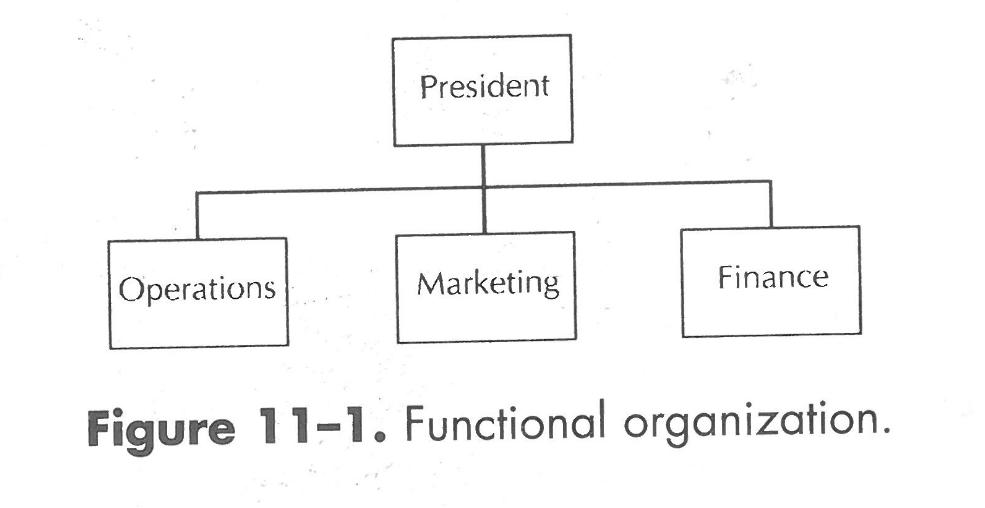
DIVISIONAL STRUCTURE
A second organizational structural alternative is divisional, if it groups people who do not work in the same product or process, serve similar customers, and/or are located in the same area or geographical region. Divisional structures attempt to avoid problems common to functional structure and are popular among organizations with diverse operations that extend across many products or services, geographical areas, customers, or work processes.
PROCESS
Departmentalization can also take place by process. This type of departmentalization, which often exists in manufacturing companies, is illustrated in Figure 11-2.
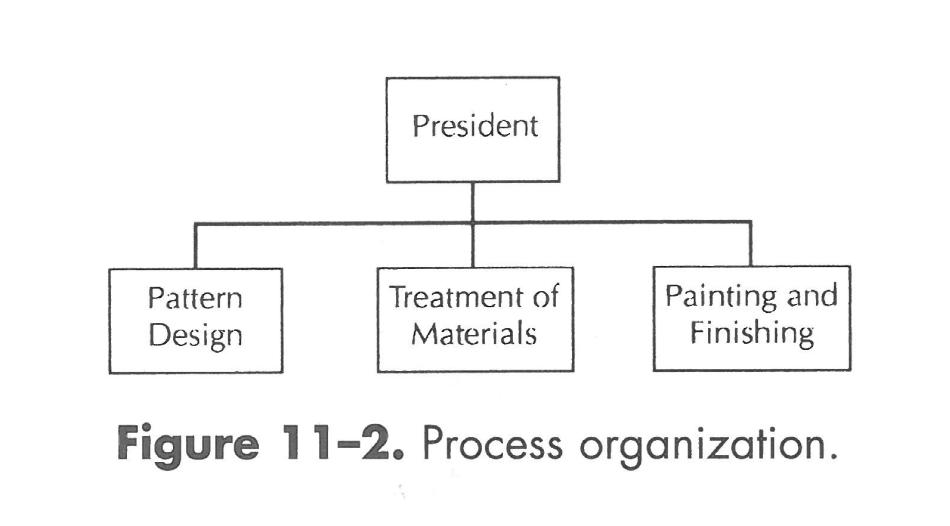 PRODUCT
PRODUCT
Whenever specialized knowledge of certain products or services is needed, departmentalization by product may be best. This usually occurs in large diversified companies. This form of departmentalization is illustrated in Figure 11-3.
.
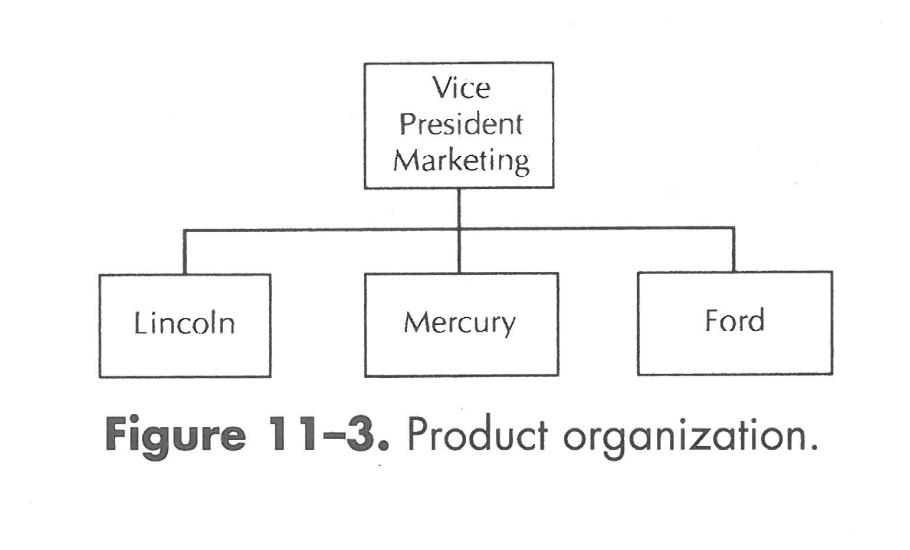
MARKET
When a need exists to provide better service to different types of markets, departmentalization by market may be the appropriate form. An example of a business serving nonprofit markets, which uses the market form of departmentalization, is shown in Figure 11-4.
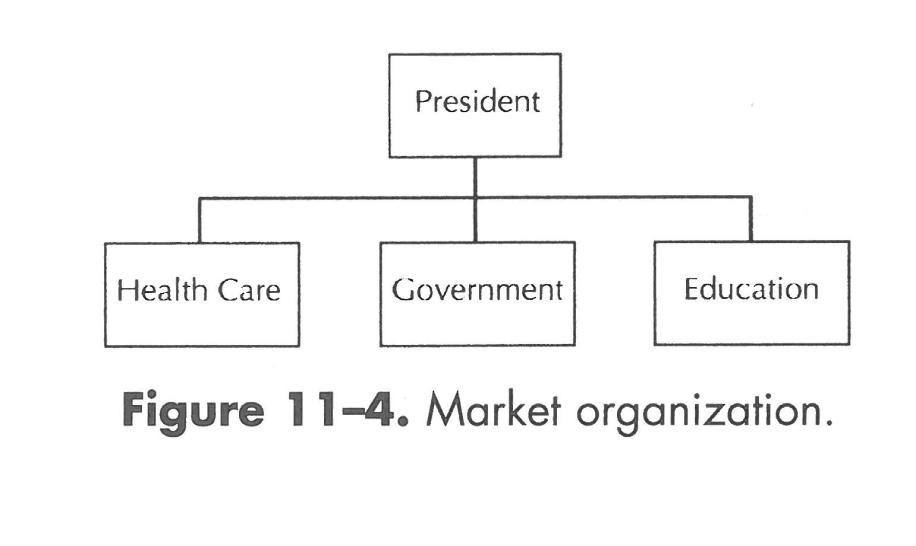
CUSTOMER
Sometimes key or major customers warrant departmentalization by customer. This is often the case in banks. See Figure 11-5.
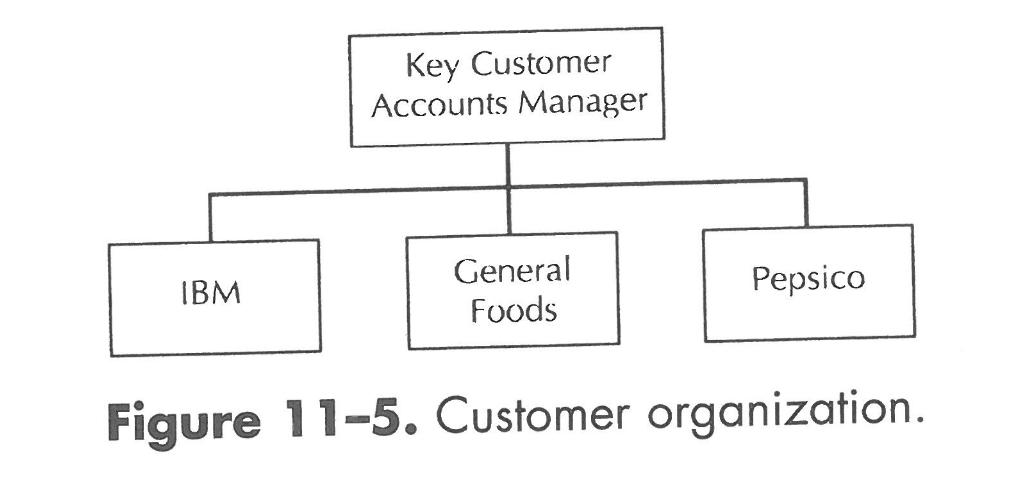 GEOGRAPHIC
AREA
GEOGRAPHIC
AREA
When organizations are spread throughout the world or have territories in many parts of a country, departmentalization by geographic area may provide better service to customers and be more cost effective. A typical example for this form of departmentalization is shown in Figure 11-6.
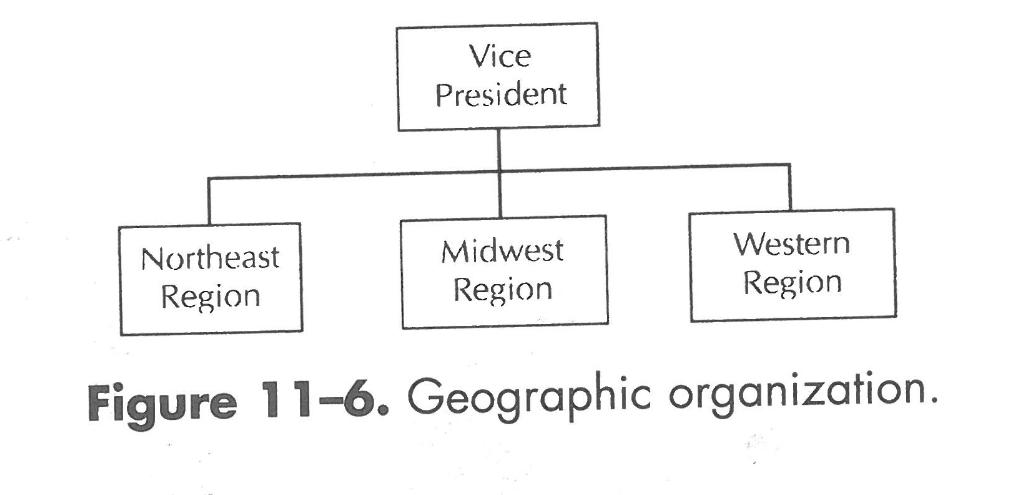 MATRIX
(PROJECT ORGANIZATION)
MATRIX
(PROJECT ORGANIZATION)
A matrix organization combines functional and divisional approaches to emphasize project or program teams. In effect, it is an attempt to gain the advantages of the two structures by using permanent cross-functional teams to integrate functional expertise with a divisional focus. Workers in a matrix structure belong to at least two formal groups at the same time. They also report to two bosses—one within the functional area and the other within the team or division. Matrix structures are also found in multinational corporations, where they offer the flexibility to deal with regional differences as well as multiple product, project, or program needs.
Departmentalization by matrix, or project, has received considerable use in recent years, particularly in such industries as aerospace (e.g., NASA). In this method, personnel with different backgrounds and experiences that bear on the project are assembled and given the specific project to be accomplished within a certain time period. When the project is completed, these specialized personnel return to their regular work assignments. An example of this form is illustrated in Figure 11-7; it often takes the shape of a diamond.
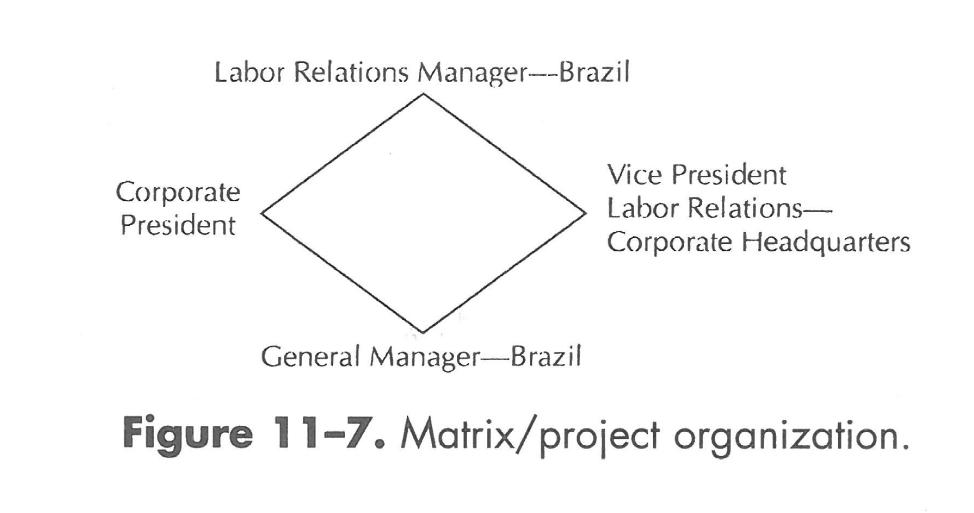 COMBINATION
APPROACH
COMBINATION
APPROACH
Many organizations, particularly large, physically dispersed, and diversified organizations, utilize several different forms of departmentalization. Figure 11-8 is an organizational chart showing the use of several forms of departmentalization.
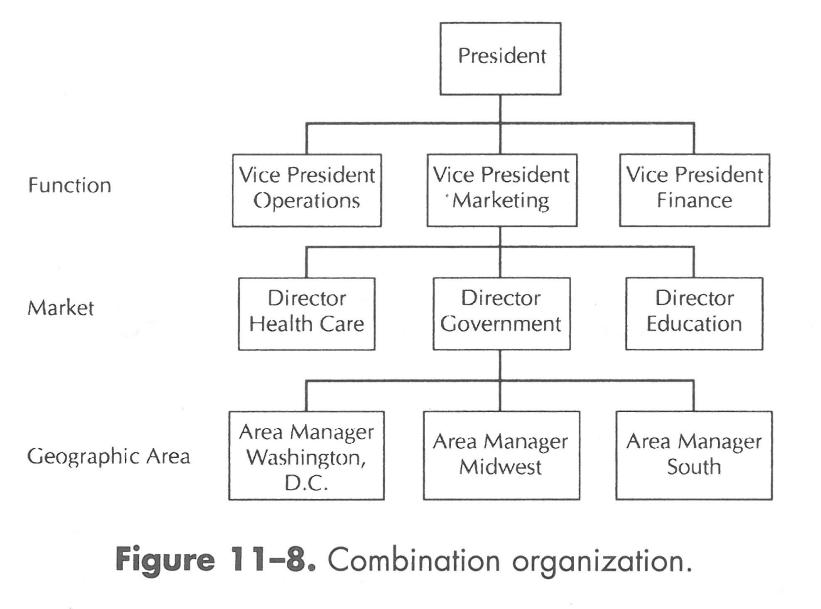 OTHER
DEVELOPMENTS IN ORGANIZATIONAL STRUCTURES
OTHER
DEVELOPMENTS IN ORGANIZATIONAL STRUCTURES
TEAM ORGANIZATION
In organizations that operate with team structures, both permanent and temporary teams are used extensively to accommodate tasks. Cross-functional teams bring together members from different functional departments or areas of work responsibility. Organizations such as General Electric, Ford, and Intel are trying to utilize teams as basic building blocks of new organizational structures as a way of changing more traditional vertical structures in favor of more horizontal ones.
As illustrated in Figure 11-9, a team structure involves teams of various types working together as needed to solve problems either on a part-time or full-time basis.
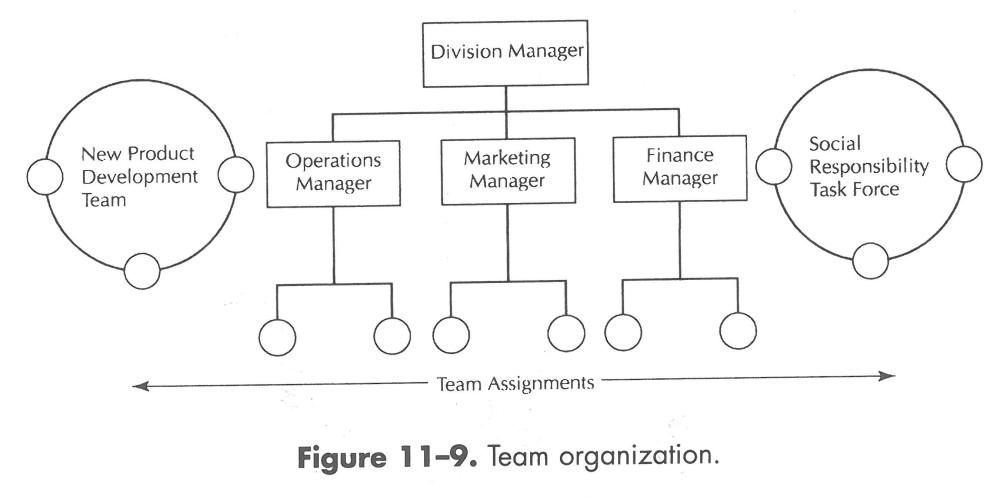
VIRTUAL ORGANIZATION (BOUNDARYLESS)
Today, “information technology innovations can result in work groups or teams that are no longer bound by departmental barriers, resulting in a concept termed the virtual workplace or boundaryless organization. Communication can also be established by voicemail, fax, e-mail, and videoconferencing, enabling people to work together or individually on their work-related tasks without coming into the office, a concept called telecommuting., a practice of working at a remote site by using a computer linked to a central office, or other employment location.”1
These are network organizations that utilize the latest communications and information technology while engaging in a shifting variety of strategic alliances and business contracts that sustain operations without the cost of owning all supportive functions. These organizations operate with the support of extensive computer networks and, in so doing, are able to work across large geographical distances with a minimum number of full-time employees.
According to Daft, “the most recent approach to departmentalization extends the idea of horizontal coordination and collaboration beyond the boundaries of the organization. Vertically integrated, hierarchical organizations are giving way to loosely interconnected groups of companies with permeable boundaries. Outsourcing, which means farming out certain activities such as manufacturing or credit processing, has become a significant trend. Moreover, partnerships, alliances, and other complex collaborative forms are now a leading approach to accomplishing strategic goals.”2
Organizing trends are toward shorter chains of command, using more cross-functional teams, task forces, and horizontal structures as well as wider spans of control as empowerment gains prominence.
YOU SHOULD REMEMBER
Determining the functions to be performed in an organization involves consideration of division of labor; this is usually accomplished by a process of departmentalization. The primary forms of departmentalization are by function, division, process, product, market, customer, geographical area, matrix (project), network organizations, or some combination of these forms.
DELEGATION—THE ART OF MANAGING
As shown earlier, the process of managing begins with the establishment of objectives. Once the objectives have been established, the functions that must be accomplished are considered. Then the work to be performed or the responsibilities to be assigned are determined. This means that it is necessary to know the personnel and physical resources needed to accomplish the objectives of the enterprise. Thus, when the functions, personnel, and other resources are grouped together by some means of departmentalization into a logical framework or organizational structure, the process of delegation begins.
Delegation is the process that makes management possible. Why? Because management is the process of getting results accomplished through others.
Delegation process, authority, and accountability
At the moment a job becomes too complex, too diverse, or too voluminous for one person, the need for delegation arises. In its simplest form, imagine the sole administrator with objectives and limited time and no subordinates with which to accomplish them. Resources permitting, the manager can create a new job, hire an employee, and assign the accomplishment of the objectives to the new employee.
To meet these responsibilities, the new employee must also have the authority to achieve them. Thus, authority is delegated along with the responsibility. The manager, however, is still ultimately responsible. By assigning some of his or her responsibilities, the manager transfers or creates accountability. If the employee does not exercise the responsibility properly, the manager can always withdraw the authority. Delegation without control is abdication.
In practice, the process of management works in conjunction with the process of delegation. Since management is the process of getting results through others, delegation facilitates that process by assigning responsibilities, delegating authority, and exacting accountability by employees.
The delegation process works as follows. The manager has certain defined objectives (i.e., results) to accomplish at the end of the budget period. He or she assigns the responsibilities (i.e., duties to be performed) to key employees, along with the commensurate authority to go with those responsibilities. Thus, the accomplishment of the assigned responsibilities should equal the defined objectives.
The manager then develops standards of performance with each key employee (i.e., the conditions that should exist when a job is done well). These standards should be developed mutually to be effective. In essence, these standards of performance become the accountability of each employee for the budget period. The successful accomplishment of the standards of performance should equal the assigned responsibilities. The process continues with the appraisal of key subordinates rated against the agreed-upon standards of performance and closes with evaluation and feedback to the beginning of the next budget cycle, when the process begins all over again. See Figure 11-10.
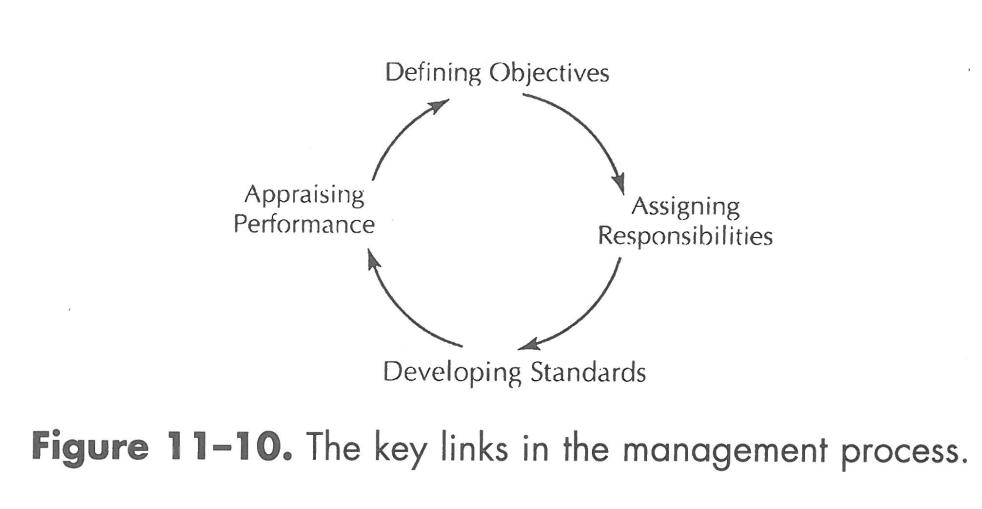 RISKS
IN DELEGATION
RISKS
IN DELEGATION
The sheer volume of management responsibilities necessitates delegation. There is somewhat of a paradox in this situation, however, because delegation involves taking risks. Among the risks of delegation are loss of control, reverse delegation, and even loss of a job.
LOSS OF CONTROL
In giving over authority to another, the manager loses some control over the proper completion of a project. The manager who has lived by the adage “If you want it done right, do it yourself” may find it difficult to delegate tasks for which he or she will ultimately be held accountable.
The key to successful delegation is assigning the right responsibilities to the right person. Of course, one never knows who the right persons are until one meets and works with them, but it must realistically be assumed that a given organization, department, or section employs at least some competent, willing, and responsible individuals. This assumption does not address itself to the fact that it is nearly impossible today for the manager to be technically superior to all employees. A staff that is not utilized effectively because of a manager’s failure to delegate is a major loss to an organization and a waste of human resources.
